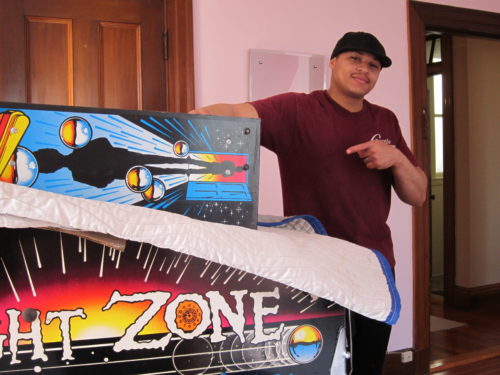
With pinball making a huge resurgence across the country, Gentle Giant Moving Company wants to make sure that these classic, beautiful machines stay damage-free while being transported. Oh, and we want the people moving them to be safe, too.
At first glance, pinball machines can appear intimidating to move because of their size, weight, and fragility. Thankfully, our skilled Giants have a few tricks up their sleeves to ensure your pinball is moved with ease.
Folding Down the Headbox
The majority of modern pinballs (made in the last 20 years or so) have a hinge system which allows the headbox to be folded down. Early pinball machines had their headboxes bolted on, using either two or four bolts. All Electro-Mechanical pinballs use this system, along with the early Solid State machines.
Later machines have hinges and use a latching system to keep the headbox upright. There may also be two bolts inside as added safety, in case the latch is broken or accidentally un-latched.
Electro-Mechanical Pinballs
For Electro-Mechanical pinball machines, you need to remove the headbox rear access panel to gain access to the bolts and plugs inside. Usually this panel has a lock on it to keep it in place, but over time the key may have been lost. Quite often, there is a screw keeping this panel in place.
Once inside, remove the bolts and unplug the large connectors that have wiring going down into the machine. You may want to label these connectors to put them back in the right spot, but they should be different sizes, making it difficult to plug back incorrectly.
You can now remove the headbox completely, or fold the headbox down onto the playfield glass. Make sure you use some foam, heavy cardboard, or blankets to protect the headbox from rubbing on the cabinet. Foam is best, as it will help keep the back glass in place.
Early Solid State Pinballs
For early Solid State Pinballs, you will need to remove the back glass. There is a lock located on the headbox in one of three locations: the left-hand side at the top, right-hand side at the top or on top of the headbox in the center.
Once unlocked, remove the back glass by lifting it up using the lift channel (at the bottom of the glass), and then pull it out from the bottom.
Then, open up the back box lamp panel by lifting the latch located on either the left-hand side or right-hand side. The panel can now swing out towards you, and give you access to the circuit boards, plugs, and the bolts. Some Gottlieb pinballs require you to lift up the lamp panel in order to swing it open.
Now that you are inside, you can remove the bolts, and any plugs that have wires going down into the machine. You may want to label these plugs to put them back in the right spot. You may not need to remove the plugs, as the wiring should be long enough to allow the headbox to be folded down.
At this point, you can lock up the lamp panel and replace the back glass.
Modern Solid State Pinballs
For Data East, Sega, and Stern Modern pinballs, there is a turnable latch system located at the back of the headbox. Using the supplied key, turn the latch 90° counter-clockwise.
For Williams, Bally, and Gottlieb, you can easily unlatch the back box at the back of the machine. This is a simple setup and requires no tools.
If you can now fold down the head box onto the cabinet, you’re done. Make sure you use some foam, heavy cardboard, or blankets to protect the headbox from rubbing on the cabinet. Foam is best, as it will also help keep the back glass in place.
If you can not fold the head box down, then you need to get inside. There is a lock located at the top of the back glass in the center. Use the supplied key to unlock, and remove the back glass by lifting it up from the bottom, and then pulling it out from the bottom.
Next, you will need to remove the display panel. You can do this by lifting it up and out. And finally, open the lamp panel. There will be a latch located on either the right-hand or left-hand side. (Some newer Williams and Bally pinballs do not have a separate amp panel, it is part of the back glass panel. And later Sega and Stern pinballs use a fluorescent tube for the back glass lighting)
Remove the two bolts, put the back box back together, and fold down the head box onto the cabinet. Make sure you use some foam, heavy cardboard, or blankets to protect the headbox from rubbing on the cabinet. Foam is best, as it will also help keep the back glass in place.
Removing the Legs
Pinball Machine legs are held in place by eight bolts. They will be either 5/8 inch or 9/16 inch heads. The modern pinballs have captive nuts or threaded plates inside for the bolts to screw into. These bolts can be removed, and the legs will come off.
But these captive nuts and threaded plates can be damaged, and the use of extra nuts may have been required. If this is the case, you will need to open up the front door of the pinball, slide out the playfield glass, and lift up the playfield.
With the front door (coin door) open, move the lock down bar latch across and remove the lock down bar. Then slide out the playfield glass, and put in a safe place. Next, lift up the playfield by placing your hand where the ball drains, and lift the playfield up.
You should now have access to any nuts that may have been used. Once any nuts have been removed, replace the playfield glass and lock down bar, and lock the front door.
Be sure to mark or remember which legs are for the front and back, as they will be adjusted differently to suit.
Loading the Pinball
You are now ready to transport your pinball machine. Before you load it, make sure you remove the pinballs so they don’t bounce around during transport.
If you are moving the pinball using a van or SUV, it may be easier to remove the legs just prior to loading the machine. Grab a friend to help and have one of you supporting the pinball, while the other removes the front legs. Slide the machine in, and then remove the back legs. It is much easier to load the machine front first.
Make sure you strap the pinball in, as you do not want it moving if you have to stop suddenly!
Move Your Pinball Machine Safely With Gentle Giant
Transporting a pinball machine may seem daunting, but with the right steps and precautions, you can ensure a smooth, damage-free move. If you’d rather leave it to the pros, Gentle Giant Moving Company is here to help. Our experienced movers know how to handle these vintage and modern machines with care, so you can focus on enjoying your next game. Contact us today for expert moving services and keep your pinball machine in top shape for years to come!

